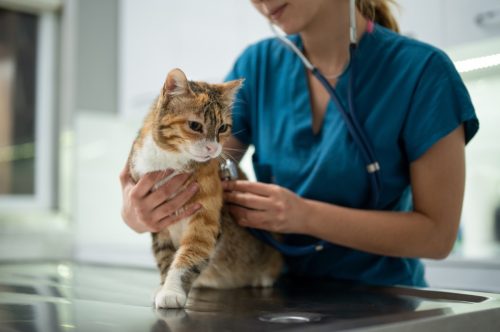Is Pet Insurance Worth It? Understand the Pros and Cons

Your pet is part of the family, which means keeping them safe and healthy is a natural part of being a loving pet owner. But does that mean you should be investing in pet insurance? This type of coverage works similarly to regular (human) insurance—if something happens to your pet, the insurance company pays a certain amount to cover the medical cost. It might sound like common sense, but many dog and cat owners have found themselves confused about the necessity of paying for these plans. So, is pet insurance worth it?
For some people, pet insurance might seem like a stretch, but depending on the individual needs of your fur baby and several other factors, it could be more vital than you think—especially if you want to avoid expensive vet care bills. At the same time, there are some notable drawbacks you should be aware of. To help you decide, we’ve spoken to pet insurance experts who gave us a breakdown of the pros and cons of pet coverage, and whether it’s something you should consider.
RELATED: The 7 Best Dogs for Beginners, Vets Say.
Should I get pet insurance?

Getting any kind of insurance is a big deal, so you’re probably asking yourself, how much coverage will my pet even really need? It’s easy to look at your four-legged pal and think they’ll be OK forever, but life is unpredictable, and that holds true for the animals we keep in our homes. Before writing off pet insurance as an unnecessary expense, consider if any of the factors below apply to you.
According to Chris Hagesfeld, the senior director of operations at Embrace Pet Insurance, you should consider coverage if you own a breed predisposed to certain health issues. For example, French bulldogs tend to suffer from hereditary conditions like breathing issues, allergies, and hypothyroidism. They’re also prone to developing chronic diarrhea, hiatal hernia, and pyloric stenosis, to name a few.
Many breeds come with their own specific risks. Even German Shepherds, typically considered one of the fittest dog breeds, are often diagnosed with genetic conditions like degenerative myelopathy, elbow and hip dysplasia, cancer, and bloat and gastric dilation-volvulus. The point is, depending on the type of dog you have and their potential health concerns, you might be spending more time in the veterinary clinic than you think. So, do your due diligence and research the medical side of your dog or cat’s breed.
Also, it’s no secret that the older you are, the more you pay for life insurance coverage—the same applies to your pet. If your furry friend is up there in age or has been diagnosed with health issues, you could be facing higher premiums and potential exclusions.
RELATED: 10 Best Ways to Pet-Proof Your Home.
How does pet insurance work?

No one knows your little furball like you, so if you think pet insurance might be a good safety measure, here’s how the process works. You’ll usually start with an annual deductible, which is the amount you have to pay before your insurance starts paying. After you pay your deductible, your insurance will provide coverage that could range from 70 percent to 90 percent of your pet’s medical bill.
Unfortunately, some companies may have high reimbursement rates, meaning that even before you’re finished paying your deductible, you’ll have to pay out even more before your insurer qualifies you for reimbursement. However, keep in mind that each insurance company is different, so your deductible and how much you’re reimbursed will likely differ depending on the company.
What are the different kinds of pet insurance coverage?

Your pet’s life can take unforeseeable turns, so you can never really predict how much you’ll actually need to cover your vet costs in an emergency.
According to Hagesfeld, insurance companies usually offer three types of plans—comprehensive plans, which cover accidents and illnesses; accident-only plans; and wellness/preventative care plans.
- Accident-only plans pay for emergencies like fractured teeth, car accidents, or animal bites. They won’t cover things like allergies, skin disorders, or diabetes. This type of insurance is usually more strict and specific to incident-induced medical issues.
- Accident and illness plans provide a more complete level of coverage for your pet. They pay for incidental injuries and illnesses, such as cancer, diabetes, arthritis, heart disease, diarrhea, and more.
- Wellness coverage will pay for preventative treatment options, like bloodwork; fecal or internal parasite exams; flea, tick, and heartworm medicine; and microchipping. It also includes routine visits and procedures. This type of coverage is usually offered as an add-on option.
“Choosing the right type depends on your individual needs and what you anticipate requiring for your pet’s care,” Hagesfeld shares.
RELATED: The Best Diets for Senior Dogs, According to Veterinarians.
What doesn’t pet insurance cover?

Before adding pet insurance to your bills, it’s crucial you know what isn’t typically covered. According to Rover, there are a few procedures that insurance companies usually don’t pay for:
- Behavioral issues: Let’s say you hire a certified professional to train your rowdy or pet—odds are your insurance will not cover it. But if you are in desperate need of sessions for your furry friend, insurance companies like Spot pay for vet-approved sessions with trainers, and Fetch reimburses a maximum of $1,000 a year for vet-recommended behavioral therapy.
- Pregnancy complications: Pet insurance offerings don’t usually include any procedure under the pregnancy or breeding umbrella. So, if your pet needs maternity care, prepare to pay out of pocket.
- Cosmetic procedures: Are you looking to fix your pup’s crooked tail? Pet insurance is similar to regular medical insurance and designed only to treat health issues. With that in mind, procedures designed to make your pet even cuter are often excluded from pet insurance plans.
- Grooming: Pet insurance is not the way to go if you want to save on grooming costs. Although cleaning your pet can feel as strenuous as surgery, many pet insurance packages will not offer it.
- Specific ages: Pet insurance companies will often not cover your pet if it is younger than eight weeks old or older than 14 years. Many companies won’t even provide coverage for senior pets.
RELATED: 10 Household Items You Didn’t Know Were Toxic to Dogs, Vets Say.
How much is pet insurance?
Your pet may be small and cute, but your pet insurance could become a huge expense if you’re not paying attention. Knowing what to expect regarding cost can help you better prepare financially.
According to a 2023 North American Pet Health Insurance Association data report, the average yearly cost for accident/illness coverage for dogs was $676, and $383 for cats. For accident-only coverage, pet owners paid an annual $204 for dogs and $116 for cats. So, to avoid paying too much for pet insurance, shop around first to find a price and coverage that’s right for you.
How do I get the most out of my pet insurance?

Pet insurance can be pricey, so maximizing its value for you and your fur baby is essential.
According to Pawlicy Advisor, using your credit card to pay for your pet’s treatment is one potential hack. When your pet insurance reimburses your card for the treatment costs, you can get cash back or reward points, which can further help cover the medical expenses.
Pawlicy also suggests telling your vet about the kind of pet insurance you have. Having this transparency with your pet’s healthcare provider could allow them to give you a better understanding and insight into all the treatment options available for your pet. If they know what your insurance offers, they can align your pet’s treatment options with what’s covered, which can help save money. Your vet could also suggest preventive treatments that keep your pet healthier in the long run, reducing future vet care costs.
We know we sound like a broken record, but pick your pet insurance based on your pet’s breed, age, and level of health. Researching the hereditary issues your dog’s breed may face will guide you to the best plan for you. But also spend time judging whether your paw pal is chill and low maintenance health-wise, or a rough rider constantly getting into trouble. This will help you decide if you’re good with a basic plan or need to splurge for an accident/illness policy with a few wellness add-ons. Putting your wild card companion on a simple plan or your lazy pet on an elaborate one is misusing your money.
Hagesfeld advises pet owners to avoid customizing their policies, as this can significantly impact premiums and out-of-pocket costs. You’ll get the most out of a company that provides quality customer service, has a solid reputation, and processes claims efficiently.
RELATED: 7 Red Flags That Your Pets Need to Be Separated, Veterinarians Warn.
What are some common misconceptions about pet insurance?

There are a few myths out there about pet insurance that can prevent pet owners from making a sound decisions about getting coverage. Here are a few we’ve debunked.
“Building your own emergency savings is always better than investing in pet insurance.”
Hagesfeld says it’s important to keep in mind that depending on your finances, saving money for your pet’s medical coverage may not always be a solid alternative to purchasing insurance.
“While saving is a good practice, unexpected veterinary emergencies can quickly exceed saved amounts,” Hagesfeld notes. “For example, complex surgeries or treatments for chronic illnesses can run into thousands of dollars. Savings may not accumulate fast enough to cover early, unexpected costs.”
“Wait until your pet is old to get insurance.”
This misconception is rooted in the idea that young pets are usually healthier.
“However, young pets are also prone to accidents and sudden illnesses, and obtaining insurance early helps avoid exclusions for pre-existing conditions that could develop as the pet ages,” Hagesfeld explains. “Moreover, premiums are generally lower for younger pets, which can lock in more favorable rates for comprehensive long-term coverage.”
“You’ll only know whether you’ll be reimbursed for a claim after your pet’s treatment.”
This isn’t necessarily true. Pet insurance companies like Embrace offer pre-approval or pre-certification processes.
“This allows pet owners to understand exactly what is covered and what their reimbursement levels will be before incurring a large expense, providing clarity and peace of mind during stressful times,” Hagesfeld shares.
RELATED: Dog Trainer Reveals the 5 Worst Things Owners Do and How to Fix Them.
How much does it cost to take your pet to the vet?

You’re probably asking yourself, how much can a vet appointment for my kitten really be? It’s not as much as a human hospital bill without insurance, but you still might have to dip into your emergency funds to cover it.
According to a 2021-2022 APPA National Pet Owners Survey, people spent $458 annually on vet appointments for surgery for their dogs, and for a regular vet visit, pet owners paid about $242 a year. When it came to cats, the average annual cost for surgical and regular visits was $201 and $178, respectively.
Hagesfeld says, “Pet insurance is especially valuable in geographic areas where veterinary costs can be significantly higher.” According to a Care Credit report, the states that had the highest average vet visit costs were Connecticut ($93.44), New Jersey ($87.11), Massachusetts ($85.06), and New York ($84.72). So, before locking in with a pet insurance company, weigh the costs and benefits depending on where you live. Then, you can decide whether paying out of pocket or getting coverage is cheaper.
How can pet owners avoid large veterinary bills?

Veterinary bills can add up quickly, so having savings tips in your back pocket is a great way to keep costs manageable.
According to Hagesfeld, “Besides getting pet insurance, maintaining your pet’s health through regular vet visits and preventative care can minimize the risk of severe health issues. Also, keeping pets safe from potential accidents by managing their environment can reduce unexpected vet visits.”
Part of preventative care also includes giving your pet the proper nutrition. Avoid pet obesity by not overfeeding your pet (do not fall for those wide eyes!), as it can lead to diabetes, respiratory issues, cancer, and high blood pressure.
According to a 2022 U.S. Pet Obesity Prevalence Survey, 61 percent of cats and 59 percent of dogs are overweight, and less than 30 percent of cat and dog owners acknowledge their pets are obese.
Regular grooming and bathing your pet is also part of preventative care because it helps ward off harmful germs and bugs.
Putting in the work at home to keep your pet safe and healthy will help reduce your visits to the vet.
RELATED: I’m a Veterinarian and These Are the 10 Things You’re Doing That Your Dog Hates.
Are there options outside of pet insurance?

If you still feel that pet insurance isn’t right for you and your dog or cat, the good news is that a policy isn’t the only way to ensure your pet’s health is covered. You have options:
- “An alternative to insurance could be setting aside a savings account specifically for pet health emergencies,” Hagesfeld suggests. Putting your funds in a high-yield savings account can help boost your earnings and give you more to work in an emergency. And if your pet maintains its health throughout its life and doesn’t need it after all, you’ve only added to your savings!
- Talk to your vet to see if they would be willing to work out a payment schedule, or check out other clinics to see if they charge less for treatment.
- You can also opt for financial assistance. The Human Society of the United States offers several resources to help you cover costs.
RELATED: The 10 Most High-Maintenance Dog Breeds, New Study Shows.
Wrapping Up
Pet insurance is a commitment, and it’s important to have all the facts before signing up for a provider. Keeping your pet safe and healthy comes in many forms, and coverage is just one part of a pet parent’s options. Consider the kind of fur baby you have, and weigh the most important factors to make the best decision for your family.
Best Life offers the most up-to-date financial information from top experts and the latest news and research, but our content is not meant to be a substitute for professional guidance. When it comes to the money you’re spending, saving, or investing, always consult your financial advisor directly.